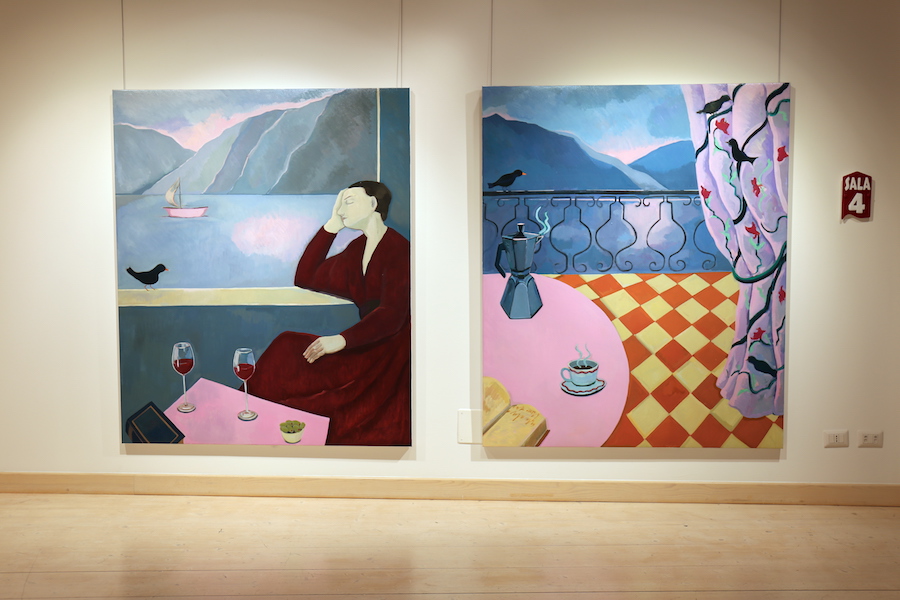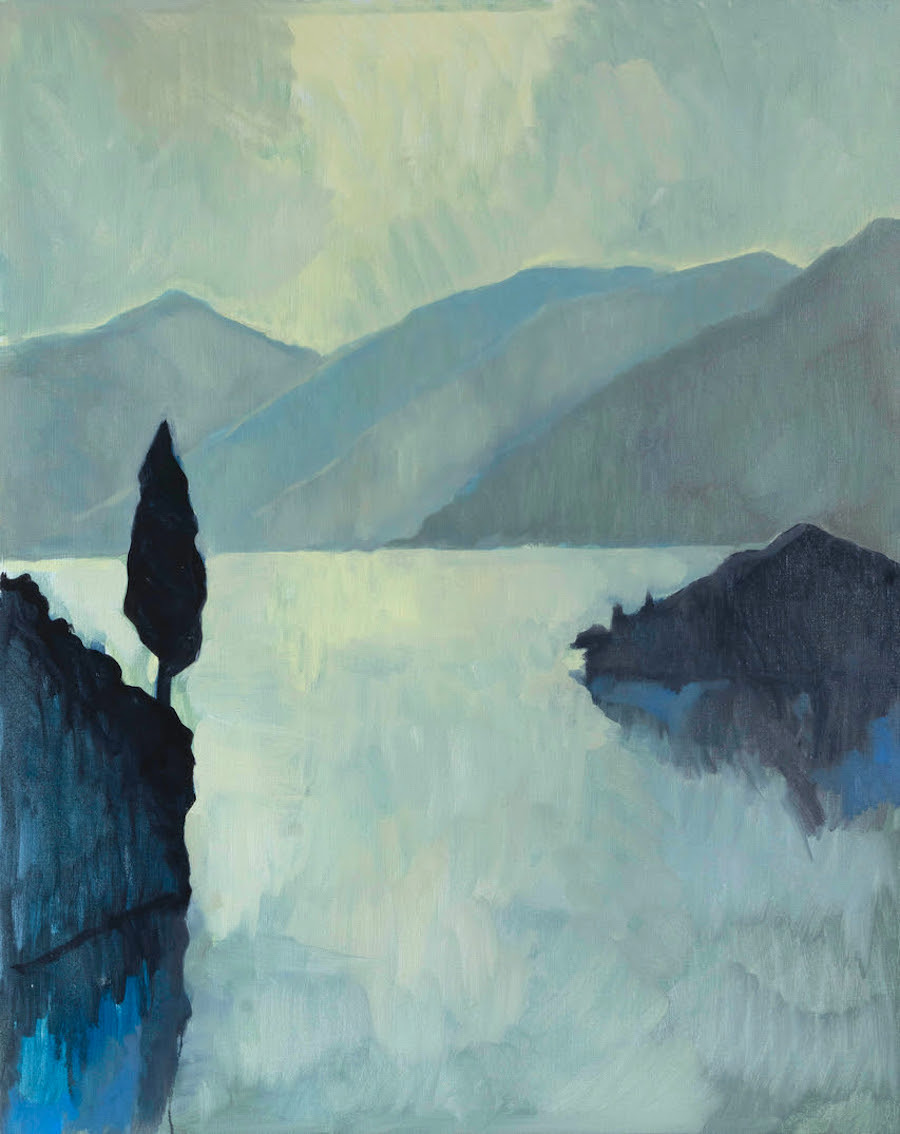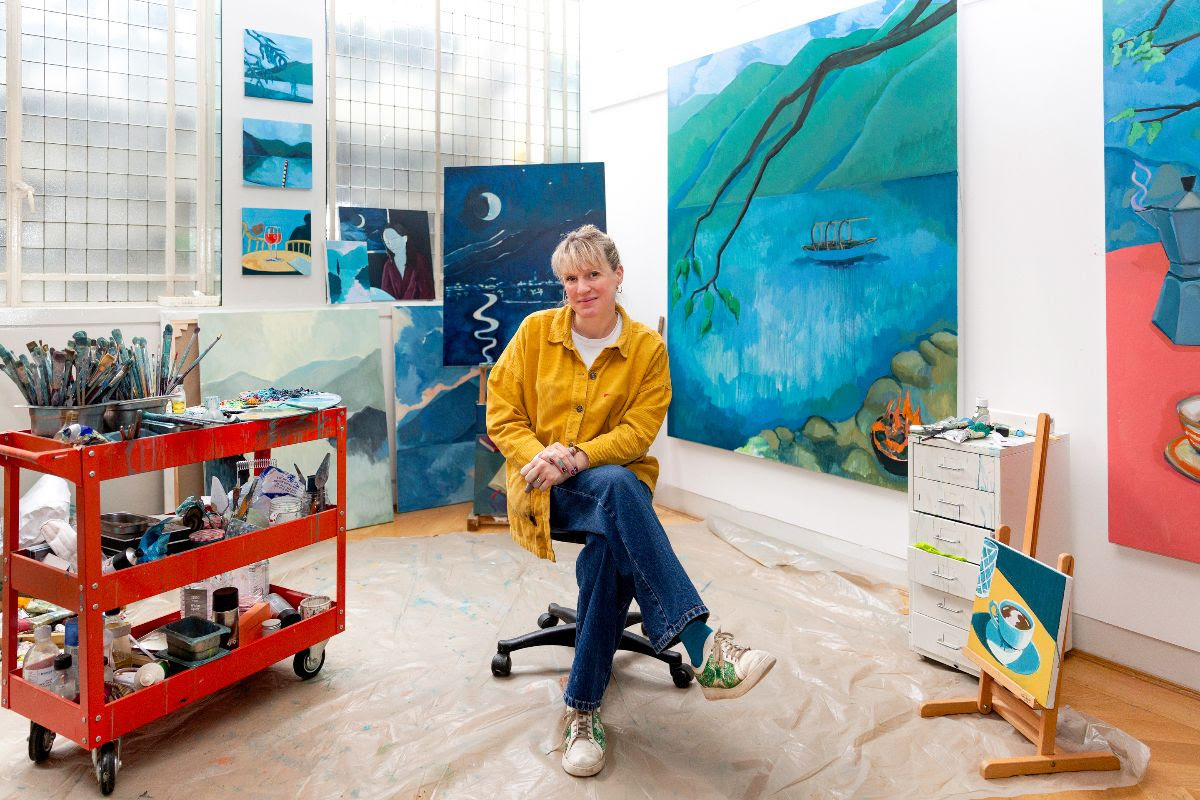“Sweel vision! Do not fade away; / Linger until my heart shall take / Into itself the summer day, / And all the beauty of the lake. / Linger until upon my brain / Is stamped an image of the scene, / Then fade into the air again…” – Henry Wadsworth Longfellow, Cadenabbia (1874)
Lake Como, a beauty so sublime, our first encounter is simultaneously tinged with the fear of its vanishing – and our own. Enshrined by sentinels of mountains that guard this gentle pool of water with their lives, it offers itself in totality to the heavens, coruscating with skylight. Along its enchanted coast, there is almost no flat land. Steep banks, cascading with hundreds of plant species, rise dramatically from the lake’s surface; grand villas and the occasional town are nestled into its rocky ridges. At the centre of all this, at the tip of a promontory jutting into the lake, is Bellagio – otherwise known as the Pearl of Como
I have come to Bellagio for the opening of STANZA, an exhibition drawn from Lake Como by Nancy Cadogan. I have come here for the pigments and I have come here for the lake. Blues draw down from the sky through the mountains into the water, magically holding their tones in polyphony. There is a hush, I notice the sound of waves lapping at the shoreline. A black bird blurs past me and lands on the branch of a plane tree. Neither glare from the midday sun nor the crush of day-trippers just disgorged from the ferry diverted my gaze. The lake holds all my attention – a vast, endlessly shifting expanse of blueness. It soaks me senseless. I fill my lungs, drawing deeply into this scene, and sigh. We all need to hold something beautiful in our minds.

“I have called this show ‘STANZA’ – as in a chapter or verse,” says Cadogan. “It marks a verse, or even a chorus in my life – one of returning, and how that has allowed me to change and be more confident in my practice.” One could say that the lake took hold of the artist’s imagination in the same way that the swimming pools of LA illuminated Hockney’s palette or the desert in New Mexico cracked open Georgia O’Keeffe’s mind. “When I first came to the lake, I tried to record my observations through painting… As time passes, and the theme of the lake keeps coming back, the paintings have become about what this huge body of water does to you… how we respond to water – its restorative, transformative power.”
There is a reluctance to share a place like this, even in writing this article I fear I am betraying its secret. For Wordsworth, it is “a treasure whom the earth keeps to herself, confined as in a depth of Abyssinian privacy”. So often eulogised, as with Venice, those in residence must share their days with ferry loads of visitors. Not only did my arrival into such a throng on a double bank holiday weekend highlight the danger of oversharing, but it also threw into relief the idea of privilege and ownership. We are in the era of the grey squirrel – and none of us know how to address it equitably. Perhaps my invitation to visit this show holds some answer: we know about a place because those who love it have shared it with us. If we accept their invitation, we must advance with respect.
Cadogan first came to the lake by invitation; two decades later, she made this body of work by invitation. “I was generously invited to make this show for the Torre delle Arti in Bellagio, a town I have been lucky to visit for twenty-plus years.” Of course, it’s not just Cadogan’s special place, as her artist’s statement attests. “I kept thinking about the Romantic sensibility and how people came to be relieved from the burden of themselves. A landscape so much larger and more significant than any human thought… For centuries, painters, poets, composers and even historians found Lake Como a place of reprieve… I find tapping into these themes of people who come before incredibly comforting.”
STANZA is “a breath, a pause, a part of poetry”. A deep connection to literature runs through much of Cadogan’s work (exhibitions Still Reading, 2018, Mind Zero, 2019), which elegantly references the genre of narrative painting. As the art historian Jo Baring says, “Each stroke of her brush echoes the lyrical nuances found in poetry.” Poetry is the most spacious form of literature, an ideal counterpart to painting. To understand it fully, we must read and then read again; meaning is revealed when we give it time. “I am really interested in that tension with language and how we tell stories, what we say, and what we choose to leave out,” says Cadogan.
In ‘After Reynolds’, a seated figure rests head in hand, elbow perched on a windowsill that opens onto the water. Pale pink blooms in the centre of the lake, catching the last rays of the setting sun; two full glasses of red wine rest on a table, its cloth soaked in a rosy hue. The woman is dressed in a gratifyingly deep shade of burgundy that sets off her alabaster skin; a blackbird has landed opposite her. As with so many of Cadogan’s paintings, there are layers of reference: the composition recalls St. Helena by Veronese at the National Portrait Gallery, and the figure might be Mary Shelley. Shelley visited the lake three times. Her second visit was recorded in Rambles in Germany and Italy. “I now made a voyage I had made years before when putting off from Como… How vividly I remembered and recognized each spot…which remained as a place adorned with magical beauty.”
Cadogan has captured Shelley in what she calls “active repose”. “Still, not sleeping, but thinking, and that is what being by this body of water does for me.” There is a sense of reverie that keys us into Romanticism and a drifting. The marine biologist Wallace J. Nichols talks about drifting in his book Blue Mind: “Being near water allows us to access a semi-meditative state known as ‘drifting’. Drifting is a special form of attention where we are engaged with the world but not focused on getting something done.” This idea of being present in the moment, undistracted by the many small tasks that crowd our minds, is central to STANZA.

Like the lake, I give each painting my attention. Across the floors in the tower, works have been grouped thematically and tonally, co-curated by Mollie Barnes. This encourages a dialogue between form and perception – what I bring to an image from my memory and how this is overlaid in my mind. There seem to be two bodies of work at play in this show. In the larger works, the lake is framed by domestic and natural elements that act on our peripheral vision to trigger a mood, or association. Branches reach into the scene like thought lines; steam rising from coffee pots mirrors the sliver of moonlight; a swan dips its head under the water. There are three paintings which are different in aspect. Entitled Faith, Love and Magic, landscapes without framing devices, they describe an essential aspect of Cadogan’s relationship to the lake. “In a way, these three became the pillars of the show. About growing up. About falling in love. About answering to things against this rocky backdrop.”
Something constant about this gentle place gave her the confidence she needed. “While I struggled to do work in those busy years with small children and tried to suppress the rising anxiety that came with those slow painting years, the lake was a comfort – soothing and constant – a reminder of the arc of the year, a different pace, and faith that the time will come when more is possible.” This exhibition might well become the touchstone to Cadogan’s career, as it consolidates everything that led her to this point and affirms the maturity of her voice.
In one of the smaller works, ‘Sometimes you have to Sit in the Dark’, there is no lake. Two smiling lines in the closed eyes of a resting face are reflected by the crescent moon that hangs quietly through the window, subtly eclipsed by the clouds. “The female figure is more pensive,” says Cadogan. “In a way, she is the necessary stanza of it all. She is lost in her thoughts in the darkness. In a way, she needs to be in that place of inner stillness and contemplation so that all the colours can sing, and all the light can shine.” The theme of stillness relates to time, not the passing of it, but having the time to do good work. Both the painting and her thoughts about it express artistic maturity, one that calls to mind the writing of Ann Patchett in Tom Lake. To me, STANZA is also about an artist stepping into her time, claiming her moment and finding the courage to share what she holds most dear.
This show is not so much an ode to the lake but an expression of gratitude for the opportunity to return cyclically to this wide-open, mutable body of water. “I think about the lake all the time, almost more than the being here,” says Cadogan in a short film about the paintings by Delia Simonetti. In Mind Zero, at the Saatchi Gallery, 2019, there was a work entitled ‘What I Dream about All the Time’, which Cadogan says “was entirely based on the lake”. Returning to the lake, she steps out of her time, and we see this reflected in her paintings, which contain no references to the contemporaneous but suggest another time. The colours sing, but all the waters in the show are still: luxurious pools of blue, composed of fixed and hovering marks, for how they absorb and refract the light.
“They differ from any other paintings that I have done; the centre of the painting is a void.” While this holds the idea of time spent between things that can be lonely and soul-searching, it also touches on the idea of not being seen. Like the mirrored surface of the water that hides what is inside, the void could also represent the idea of not being seen, heard, or shown. Just before the Covid pandemic, Cadogan was invited to make work for the Keats-Shelley Memorial House, at the foot of the Spanish steps in Rome, to mark the bicentenary of Keats’ death in 2021. Painting through the first lockdown, the show opened as we entered our second lockdown. “Underpinning this body of new paintings is an exploration of how the landscape can provide moments of solace. Thus, three years after the pandemic, Lake Como becomes a location simultaneously of inspiration and emotional healing.” Simon Martin – Reflected Light: Nancy Cadogan at Lake Como
Like an exclamation mark, the blackbird is a leitmotif that flits through the paintings. It sits on a woman’s shoulder in the first painting we see ‘Listen to the Song’; lands on the balcony and is found repeated in the fabric of ‘When the Lake Calls’. We notice the repetition if we are paying attention. We are in the era of the hyper-attention economy. “For most people, attention is not a point of visual focus by something nearer to a warm breeze through an open window, carrying fragrances from far away,” says Nathan Heller in The Battle for Attention for The New Yorker. “We feel its power when we read an absorbing novel. We find it when we visit a new place and notice everything for the first time.”
I would venture we recover our attention through art. My memory of Lake Como is not the lake but a Cadogan painting of the lake. My response to this place flows through my memory of her work. It reminds me why art became so central in my own peripatetic life, in which there was no lake to return to. I have this extraordinary image instead, and I hold in it my mind, like hope or faith, that I will find stillness one day. Even if we only see it once, we can cultivate the image forever if we tend to its memory. “Where tones of nature smoothed by learned art/ May flow in lasting current.”- Henry Wadsworth Longfellow
12 May – 5 August 2024 Torre delle Arti Bellagio Salita Plinio, 25, 22021 Bellagio, Como, Italy
Nico Kos Earle – May 2024

